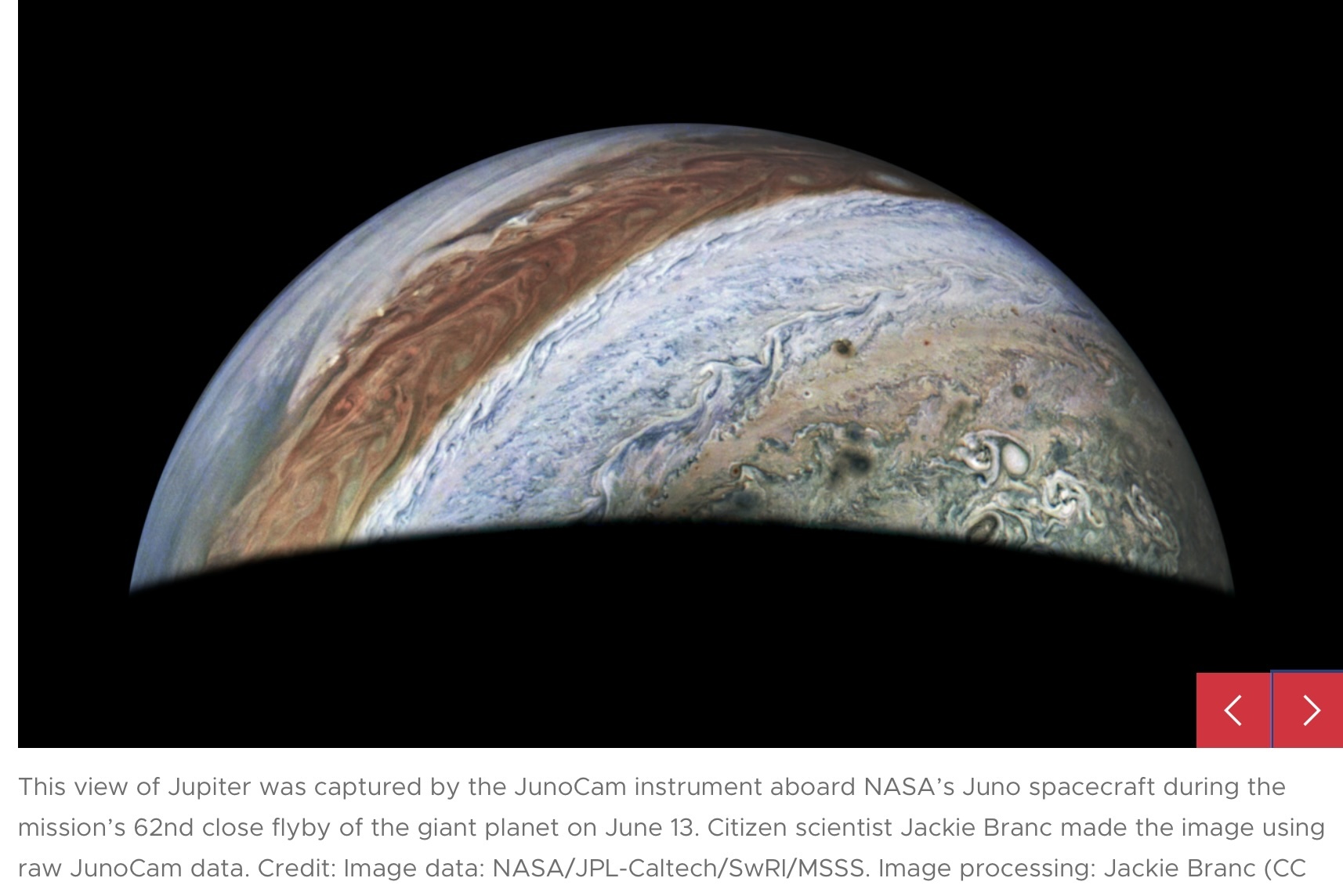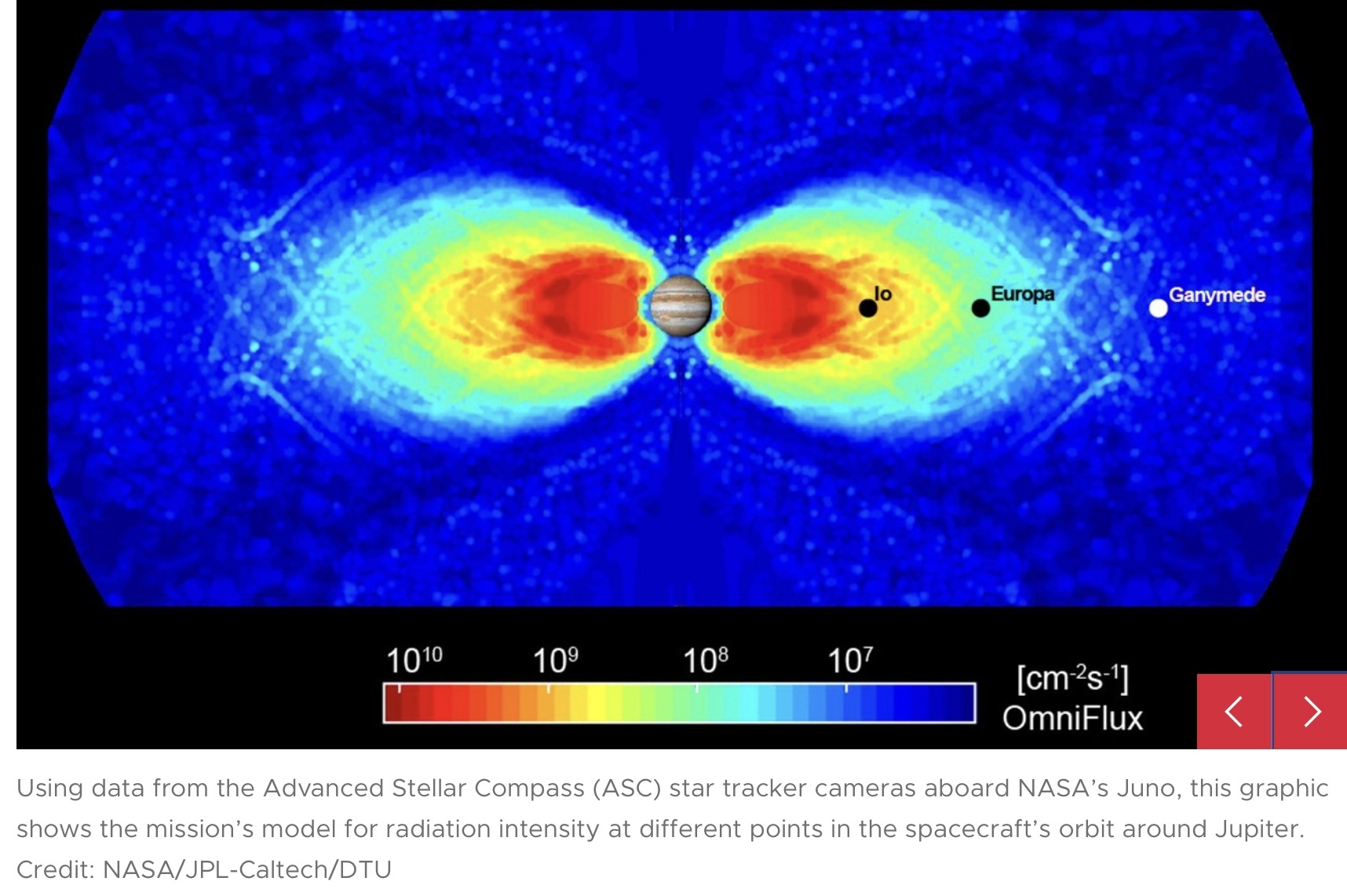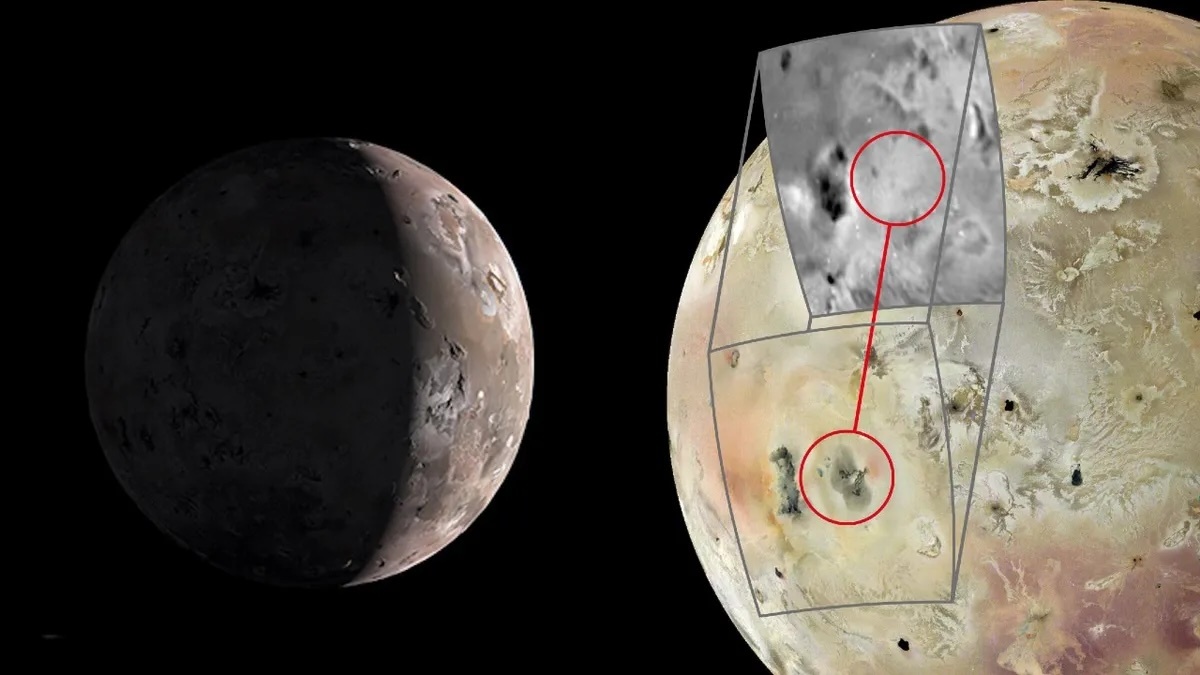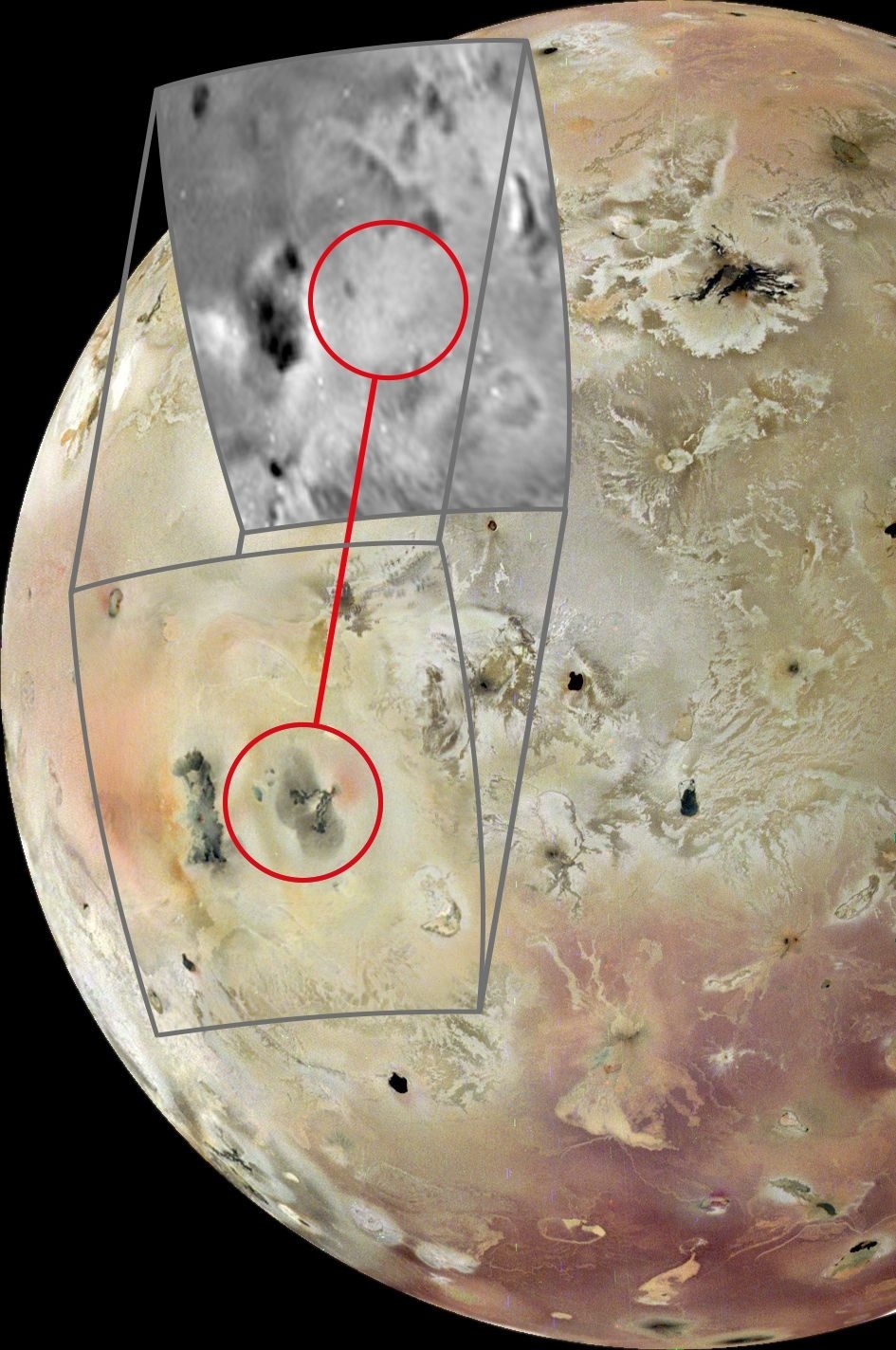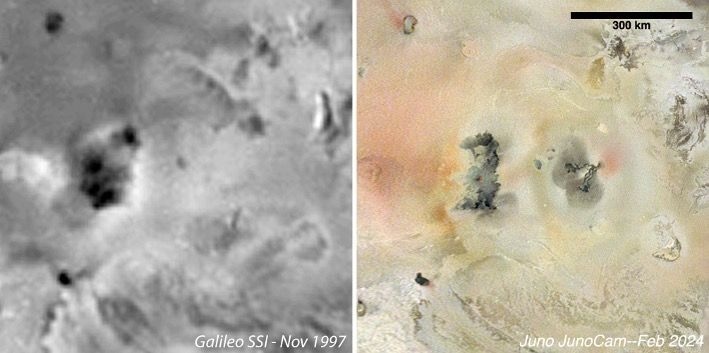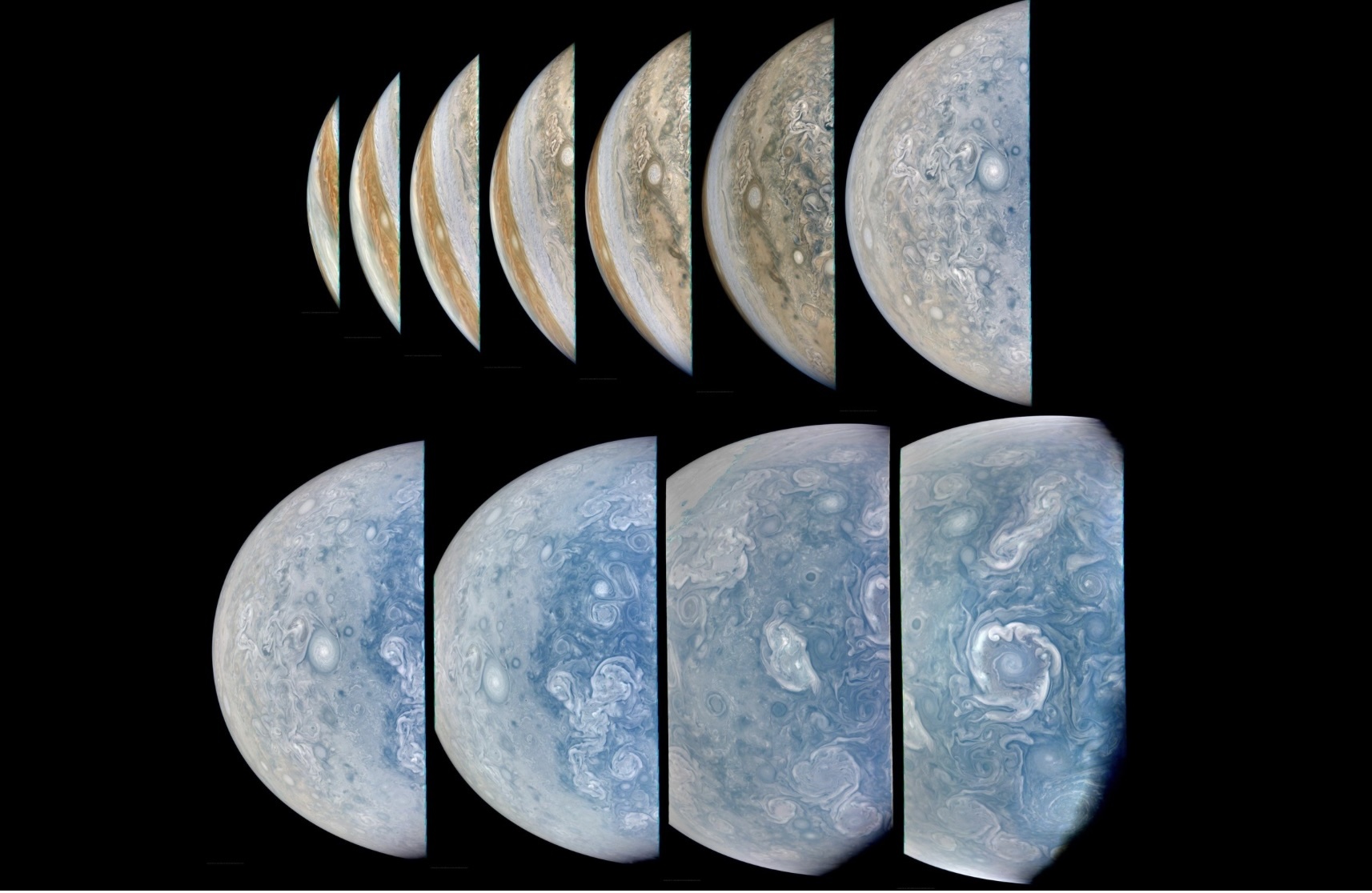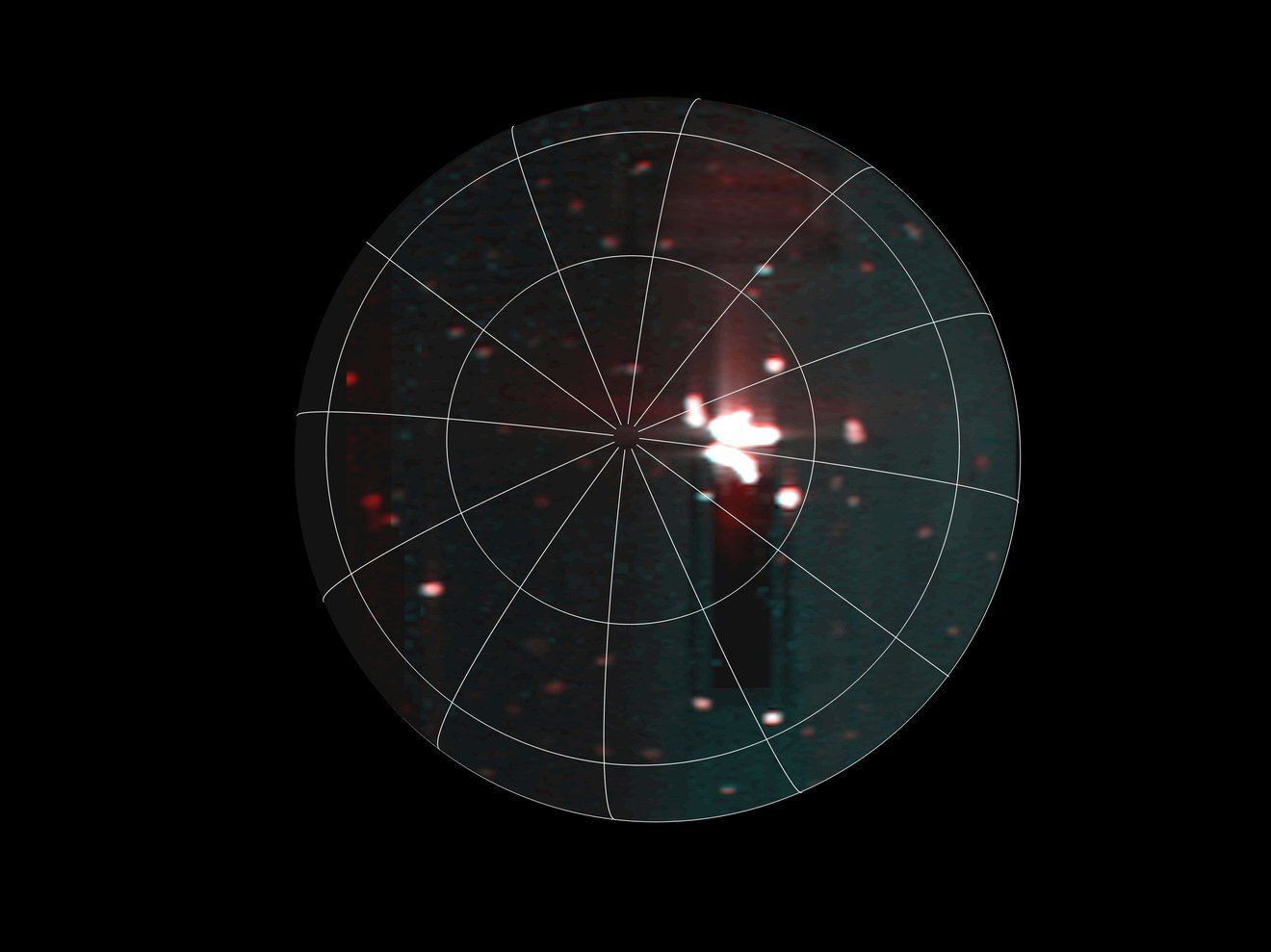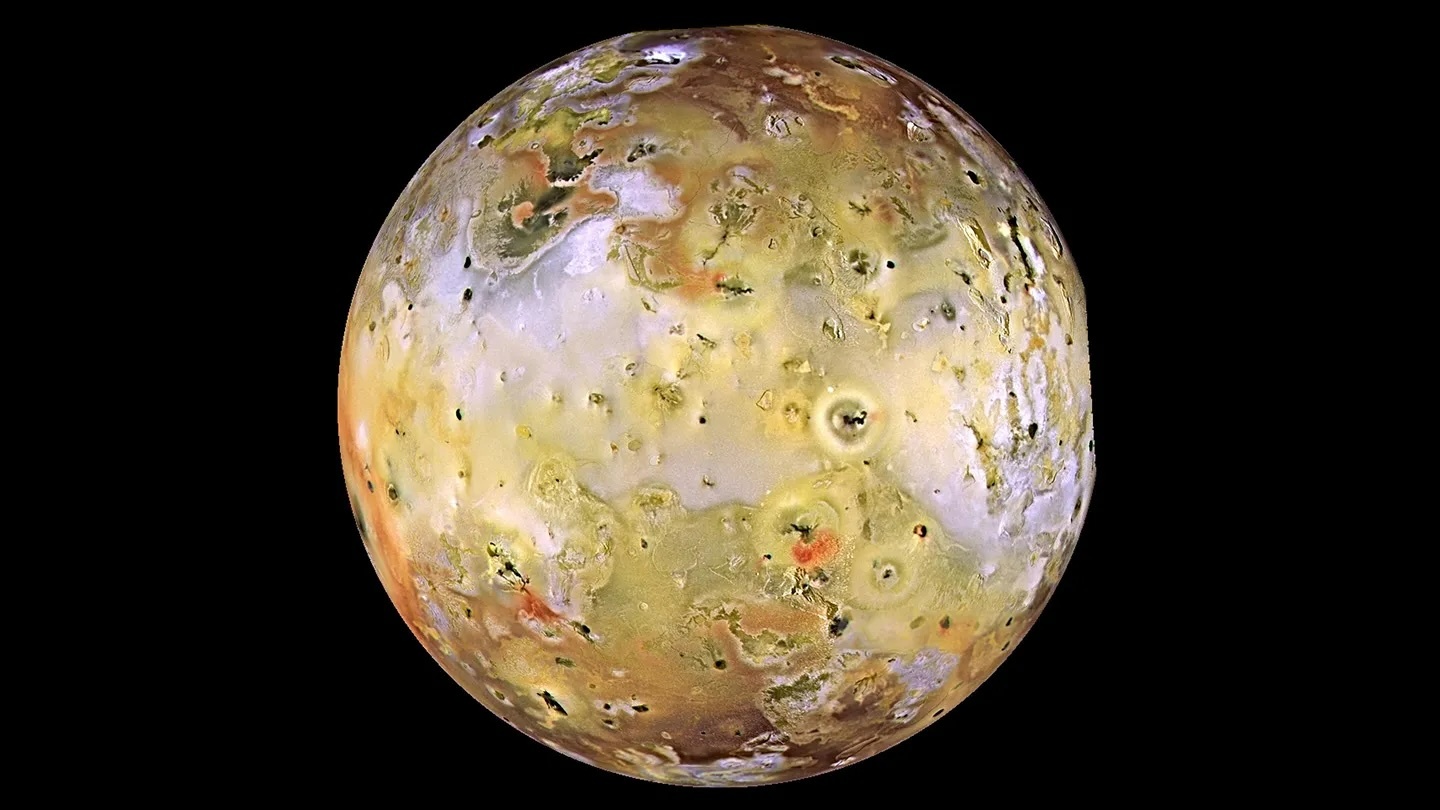Scientists with NASA’s Juno mission have discovered a volcanic hot spot in the southern hemisphere of Jupiter’s moon Io. The hot spot is not only larger than Earth’s Lake Superior, but it also belches out eruptions six times the total energy of all the world’s power plants. The discovery of this massive feature comes courtesy of Juno’s Jovian Infrared Auroral Mapper (JIRAM) instrument, contributed by the Italian Space Agency.
“Juno had two really close flybys of Io during Juno’s extended mission,” said the mission’s principal investigator, Scott Bolton of the Southwest Research Institute in San Antonio. “And while each flyby provided data on the tormented moon that exceeded our expectations, the data from this latest — and more distant — flyby really blew our minds. This is the most powerful volcanic event ever recorded on the most volcanic world in our solar system — so that’s really saying something.”
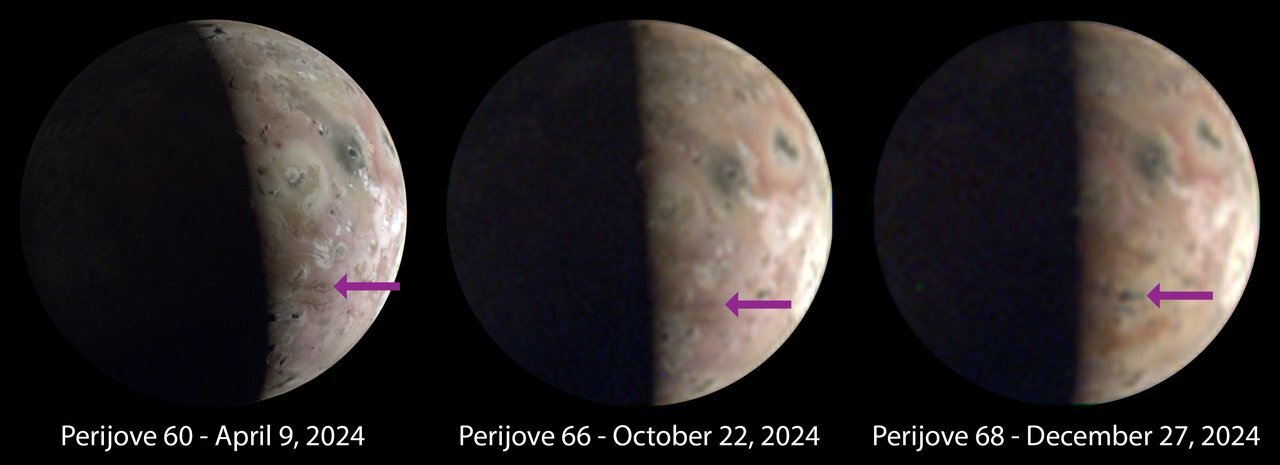
Images of Io captured in 2024 by the JunoCam imager aboard NASA’s Juno show significant and visible surface changes (indicated by the arrows) near the Jovian moon’s south pole. These changes occurred between the 66th and 68th perijove, or the point during Juno’s orbit when it is closest to Jupiter.
Credit: NASA/JPL-Caltech/SwRI/MSSS Image processing by Jason Perry
The source of Io’s torment: Jupiter. About the size of Earth’s Moon, Io is extremely close to the mammoth gas giant, and its elliptical orbit whips it around Jupiter once every 42.5 hours. As the distance varies, so does the planet’s gravitational pull, which leads to the moon being relentlessly squeezed. The result: immense energy from frictional heating that melts portions of Io’s interior, resulting in a seemingly endless series of lava plumes and ash venting into its atmosphere from the estimated 400 volcanoes that riddle its surface.
Close Flybys
Designed to capture the infrared light (which isn’t visible to the human eye) emerging from deep inside Jupiter, JIRAM probes the gas giant’s weather layer, peering 30 to 45 miles (50 to 70 kilometers) below its cloud tops. But since NASA extended Juno’s mission, the team has also used the instrument to study the moons Io, Europa, Ganymede, and Callisto.
During its extended mission, Juno’s trajectory passes by Io every other orbit, flying over the same part of the moon each time. Previously, the spacecraft made close flybys of Io in December 2023 and February 2024, getting within about 930 miles (1,500 kilometers) of its surface. The latest flyby took place on Dec. 27, 2024, bringing the spacecraft within about 46,200 miles (74,400 kilometers) of the moon, with the infrared instrument trained on Io’s southern hemisphere.
Io Brings the Heat
“JIRAM detected an event of extreme infrared radiance — a massive hot spot — in Io’s southern hemisphere so strong that it saturated our detector,” said Alessandro Mura, a Juno co-investigator from the National Institute for Astrophysics in Rome. “However, we have evidence what we detected is actually a few closely spaced hot spots that emitted at the same time, suggestive of a subsurface vast magma chamber system. The data supports that this is the most intense volcanic eruption ever recorded on Io.”
The JIRAM science team estimates the as-yet-unnamed feature spans 40,000 square miles (100,000 square kilometers). The previous record holder was Io’s Loki Patera, a lava lake of about 7,700 square miles (20,000 square kilometers). The total power value of the new hot spot’s radiance measured well above 80 trillion watts.
Picture This
The feature was also captured by the mission’s JunoCam visible light camera. The team compared JunoCam images from the two previous Io flybys with those the instrument collected on Dec. 27. And while these most recent images are of lower resolution since Juno was farther away, the relative changes in surface coloring around the newly discovered hot spot were clear. Such changes in Io’s surface are known in the planetary science community to be associated with hot spots and volcanic activity.
An eruption of this magnitude is likely to leave long-lived signatures. Other large eruptions on Io have created varied features, such as pyroclastic deposits (composed rock fragments spewed out by a volcano), small lava flows that may be fed by fissures, and volcanic-plume deposits rich in sulfur and sulfur dioxide.
Juno will use an upcoming, more distant flyby of Io on March 3 to look at the hot spot again and search for changes in the landscape. Earth-based observations of this region of the moon may also be possible.
“While it is always great to witness events that rewrite the record books, this new hot spot can potentially do much more,” said Bolton. “The intriguing feature could improve our understanding of volcanism not only on Io but on other worlds as well.”
Quelle: NASA
----
Update: 8.03.2025
.
Jupiter’s moon Io, seen here in a photo from the Galileo spacecraft, is the most volcanically active body in the solar system. JPL/NASA, UNIVERSITY OF ARIZONA
Jupiter’s moon Io, the most volcanically active body in the solar system, is littered with hundreds of erupting volcanoes. High-resolution images now reveal several dozen lava lakes, researchers report in the February Journal of Geophysical Research: Planets. These lakes are far larger than their analogs on Earth, and their structure sheds light on how magma moves beneath the surface of Io.
Io’s volcanism — probably present over the moon’s entire 4.6-billion-year existence — was discovered when the Voyager spacecraft flew by in 1979. The volcanic activity is caused by the intense gravitational pulls of Jupiter and nearby moons, which deform Io by tens of meters. “This squeezing is heating the body,” says Alessandro Mura, a planetary scientist at Italy’s National Institute for Astrophysics in Rome.
Using infrared images from NASA’s Juno spacecraft, which has orbited Jupiter since 2016, Mura’s team pinpointed more than 40 lava lakes ranging in diameter from about 10 to 100 kilometers. That’s much larger than the lava lakes found on Earth, which tend to measure tens to hundreds of meters across.
Volcanic activity and lava flows are known to be more extreme on other worlds, says Einat Lev, a volcanologist at Columbia University’s Lamont-Doherty Earth Observatory in Palisades, N.Y., who was not involved in the research. “A lot of planetary flows are much bigger” than Earth’s, she says.
Previous studies have reported lava lakes on Io but with only limited detail, Mura and colleagues note. The researchers found that most of the newly analyzed lava lakes are hottest at their perimeters. This suggests that these lakes are largely capped by a cooler crust of solidified lava.
That idea makes sense given the conditions on Io, says Alfred McEwen, a planetary geologist at the University of Arizona in Tucson who was not involved in the research. “It’s very, very cold. A crust starts forming immediately.”
Molten lava remains exposed at the lake edges probably because of how the lakes interact with their surroundings, Mura and his colleagues propose. Io’s lava lakes sit within caldera-like features with steep or even vertical walls, so as a lake fills or drains, its outer crust scrapes against those walls, breaking up the crust there and exposing fresh lava.
The findings also shed light on how magma moves beneath Io’s surface and feeds these lakes. None of the analyzed lakes had a hot spot in the middle, Mura notes, suggesting that magma doesn’t simply upwell at a lake’s center.
He and his team hope to understand whether multiple lava lakes are fed by a common magma reservoir. In that case, different lakes might change in size in lockstep. Such observations could help reveal details about the plumbing that powers Io’s volcanism, Mura says. “These can be a glimpse beneath the surface of Io.”
Quelle: ScienceNews
----
Update: 5.04.2025
.
Major storms on Jupiter can leave a fingerprint in the planet's atmosphere
Jovian storms can rework the whole chemical makeup of Jupiter's deep atmosphere by picking up ammonia from and dropping it somewhere else.
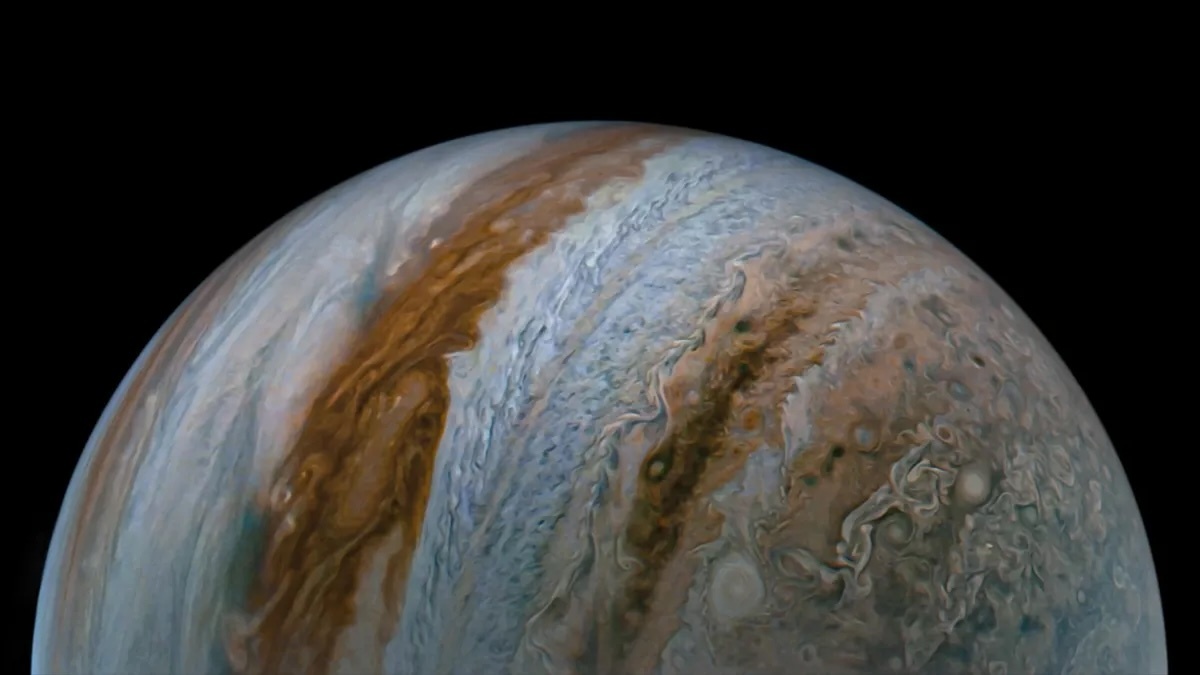
NASA's Juno spacecraft captured this view of Jupiter during the mission’s 54th close flyby of the giant planet on Sept. 7, 2023. (Image credit: Image data: NASA/JPL-Caltech/SwRI/MSSS. Image processing by Tanya Oleksuik CC BY NC SA 3.0)
It would appear that a really big storm on Jupiter can leave a noticeable mark in the planet's atmosphere.
A recent study tapped into data collected by the Jupiter-orbiting spacecraft Juno and the Hubble Space Telescope to start piecing together how this gas giant's storms churn up the world's atmosphere — even surprisingly far below the clouds. This churning involves the storms dredging up ammonia in some places and hurling it far into the Jovian depths as slushy hailstones in others.
The result, it appears, is that patches of ammonia gas end up buried deep in some parts of Jupiter’s lower atmosphere, while other areas have far less ammonia than they normally would. In other words, some storms on Jupiter can leave behind a fingerprint, reworking the whole chemical makeup of the planet's atmosphere.
Storm warning on Jupiter
A huge storm on Jupiter broke out in December of 2016, just south of the planet's equator and about 60 degrees east of the famous Great Red Spot. Amateur astronomer Phil Miles was the first to spot this storm in February of 2017 — and the timing couldn't have been better.
Juno was about to make its fourth close flyby of Jupiter, and the Atacama Large Millimeter/submillimeter Array here on Earth, along with the Hubble Space Telescope in orbit, were also pointed at the gas giant. This meant astronomers could see Jupiter in different wavelengths of light at the same time.
Armed with data from three observatories, University of California, Berkeley, planetary scientist Chris Moeckel and his colleagues just needed to figure out what kinds of updrafts, downdrafts and heat transfer could best explain what Juno, Hubble and ALMA saw during and after the storm. The team simulated the inner workings of Jupiter's atmosphere, which revealed that the massive storm had stirred up the planet's atmosphere dozens of miles below even the lowest-hanging cloud decks.
To understand exactly what that means, we first need to understand one of the quirks of describing the weather on Jupiter.
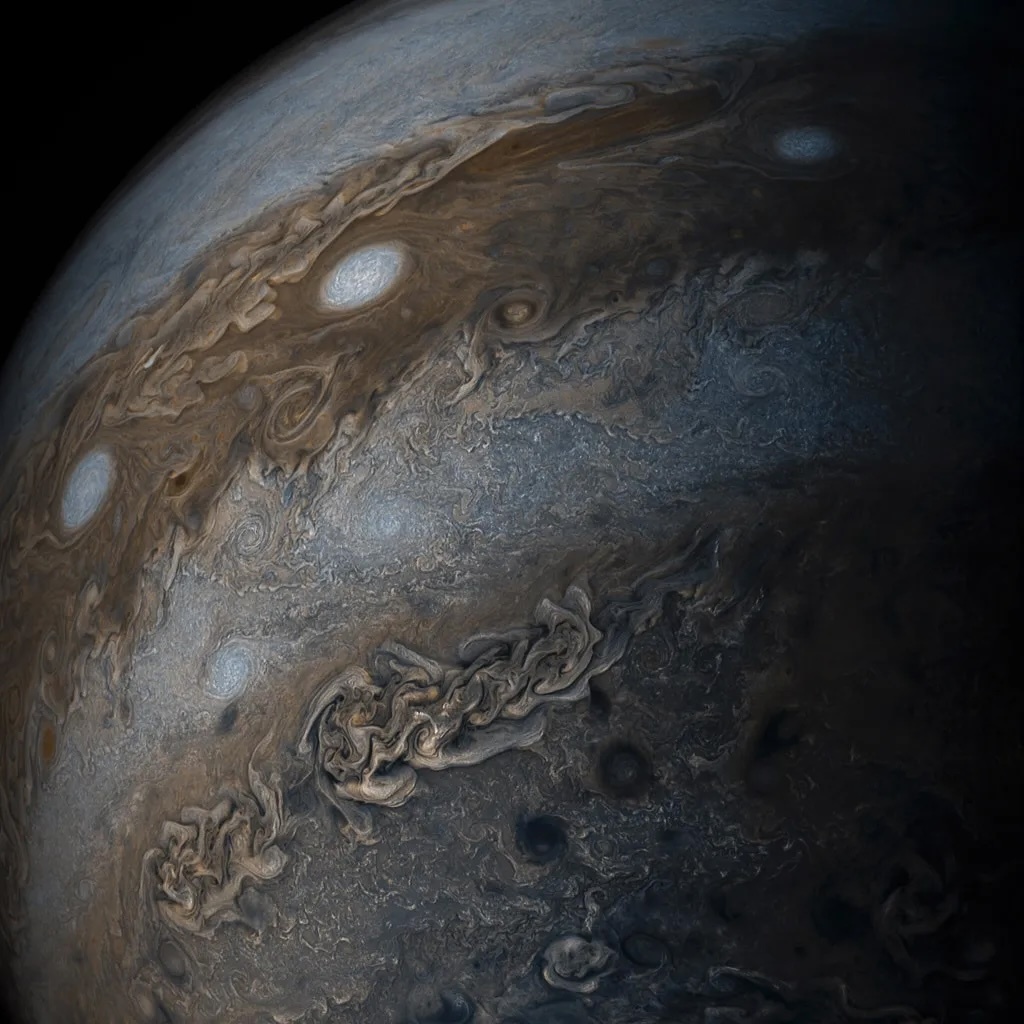
Jupiter’s cloud bands — seen here in this image created by citizen scientists Gerald Eichstädt and Seán Doran, using data from NASA's Juno spacecraft — extend more than 1,000 miles (1,600 kilometers) into the planet’s interior, studies suggest. (Image credit: NASA/JPL-Caltech/SwRI/MSSS/Gerald Eichstädt/Seán Doran)
It's hard to measure altitudes in Jupiter's atmosphere, because the planet doesn't have a surface in the usual sense (there's liquid somewhere below all those deep layers of gas, but it's never been directly measured), so scientists rely on pressure instead. There's a level in Jupiter's middle stratosphere at which the atmospheric pressure is about the same as it is at sea level here on Earth, and that makes a useful baseline for saying how deep things are in Jupiter's atmosphere. The dense, heavy water vapor clouds where huge Jovian storms begin are about 82 miles (132 kilometers) below that level, where the air pressure is about 10 times higher than it is at sea level on Earth.
Furthermore, Juno's data suggests the lowest-hanging clouds present during the early 2017 storm loomed several miles lower than even that level — thus, in the storm's wake, the atmosphere had been stirred up deep, deep below the clouds.
Violent updrafts and mushy hail
Juno and Hubble images from 2017 showed a powerful updraft near the heart of the storm, pumping ammonia from deep within Jupiter's atmosphere and rushing it upward to the peaks of the towering storm clouds. Below that plume, Juno and Hubble saw that the updraft had "dried out" most of the ammonia from a patch of Jupiter's atmosphere stretching down at least tens of miles below the base of the storm clouds.
Wrapped around the bright spot of the updraft, darker patches shown in Juno's data mark where downdrafts carried a slushy mix of ammonia and water back down to the Jovian depths. And surprisingly, the ammonia was plunging much deeper into the atmosphere than Moeckel and his colleagues expected.
If the clouds in the early 2017 storm had just been raining big liquid droplets of ammonia, they shouldn't have been able to fall very deep into the atmosphere before the higher temperature and pressure evaporated the droplets — and the resulting gas wouldn't keep falling. It would just hang out, forming a new ammonia gas layer. But instead, the ammonia fell deeper — according to Moeckel and his colleagues' simulations, down to a depth where the pressure in Jupiter’s atmosphere is about 30 times higher than that at sea level on Earth. That means the storm was most likely dropping down big, slushy mush balls of mixed water and ammonia.
Mush balls are a weird weather phenomenon on Jupiter that astronomers first pieced together (also from Juno data) a few years ago
Ammonia stays liquid at much lower temperatures than water can, which means droplets of liquid ammonia can mingle with icy crystals of water in Jupiter's storm clouds. The resulting mix is a ball of slush just solid enough to stay together, but definitely mushier than, say, a hailstone; picture a wet snowball. And mush balls raining out of a storm could fall much faster than raindrops, so they'd make it much farther before succumbing to evaporation.
The result is that deep within Jupiter's atmosphere, there are patches of ammonia that fell as mush balls from storms raging dozens of miles above – and that ammonia will stay buried down there until the next big storm dredges it up.
The scientists published their work on March 28 in the journal Science Advances.
Quelle: SC
----
Update: 11.04.2025
.
NASA’s Juno Back to Normal Operations After Entering Safe Mode
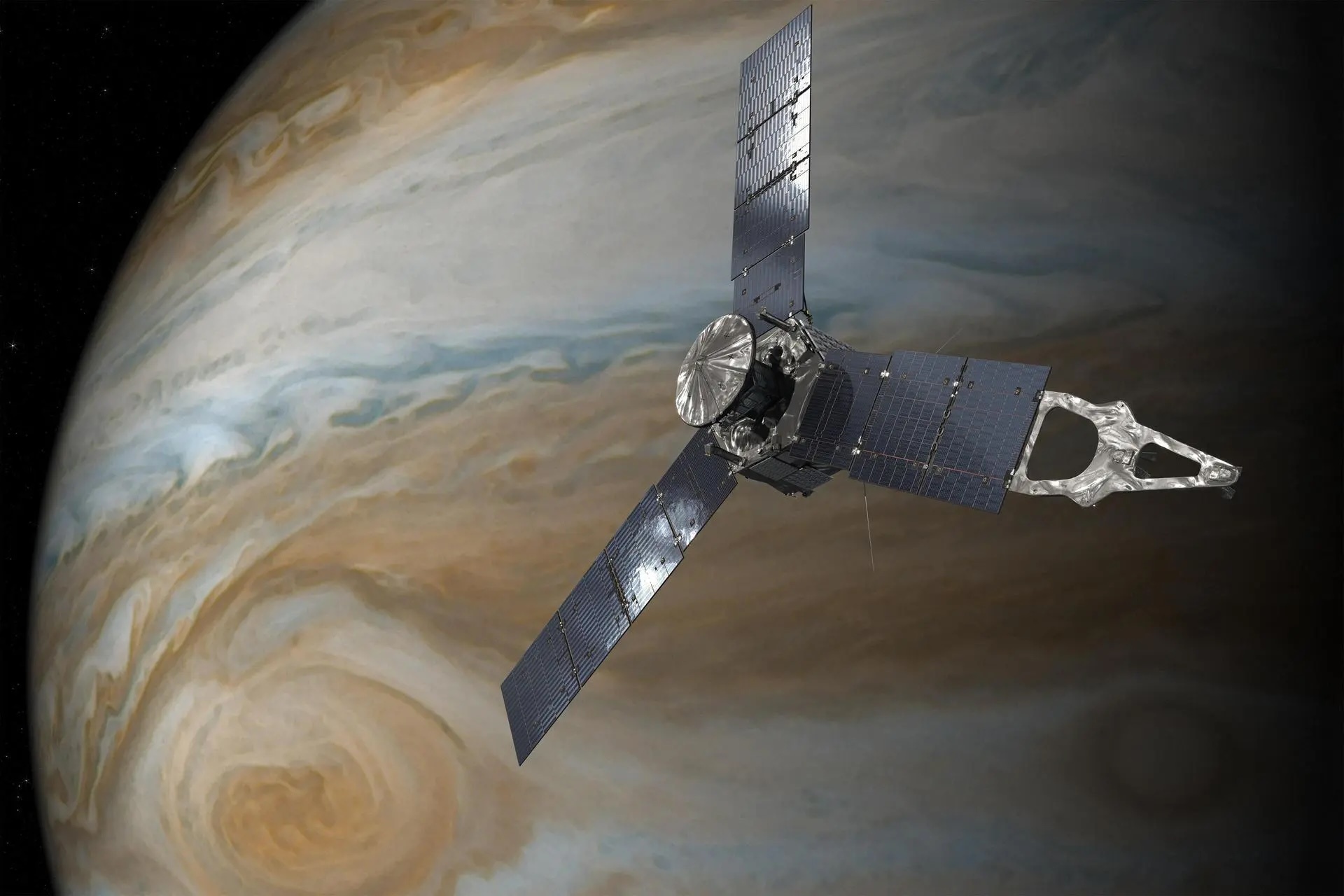
The spacecraft was making its 71st close approach to Jupiter when it unexpectedly entered into a precautionary status.
Data received from NASA’s Juno mission indicates the solar-powered spacecraft went into safe mode twice on April 4 while the spacecraft was flying by Jupiter. Safe mode is a precautionary status that a spacecraft enters when it detects an anomaly. Nonessential functions are suspended, and the spacecraft focuses on essential tasks like communication and power management. Upon entering safe mode, Juno’s science instruments were powered down, as designed, for the remainder of the flyby.
The mission operations team has reestablished high-rate data transmission with Juno, and the spacecraft is currently conducting flight software diagnostics.The team will work in the ensuing days to transmit the engineering and science data collected before and after the safe-mode events to Earth.
Juno first entered safe mode at 5:17 a.m. EDT, about an hour before its 71st close passage of Jupiter — called perijove. It went into safe mode again 45 minutes after perijove. During both safe-mode events, the spacecraft performed exactly as designed, rebooting its computer, turning off nonessential functions, and pointing its antenna toward Earth for communication.
Of all the planets in our solar system, Jupiter is home to the most hostile environment, with the radiation belts closest to the planet being the most intense. Early indications suggest the two Perijove 71 safe-mode events occurred as the spacecraft flew through these belts. To block high-energy particles from impacting sensitive electronics and mitigate the harmful effects of the radiation, Juno features a titanium radiation vault.
Including the Perijove 71 events, Juno has unexpectedly entered spacecraft-induced safe mode four times since arriving at Jupiter in July 2016: first, in 2016 during its second orbit, then in 2022 during its 39th orbit. In all four cases, the spacecraft performed as expected and recovered full capability.
Juno’s next perijove will occur on May 7 and include a flyby of the Jovian moon Io at a distance of about 55,300 miles (89,000 kilometers).
NASA’s Jet Propulsion Laboratory, a division of Caltech in Pasadena, California, manages the Juno mission for the principal investigator, Scott Bolton, of the Southwest Research Institute in San Antonio. Juno is part of NASA’s New Frontiers Program, which is managed at NASA’s Marshall Space Flight Center in Huntsville, Alabama, for the agency’s Science Mission Directorate in Washington. The Italian Space Agency (ASI) funded the Jovian InfraRed Auroral Mapper. Lockheed Martin Space in Denver built and operates the spacecraft. Various other institutions around the U.S. provided several of the other scientific instruments on Juno.
Quelle: NASA
